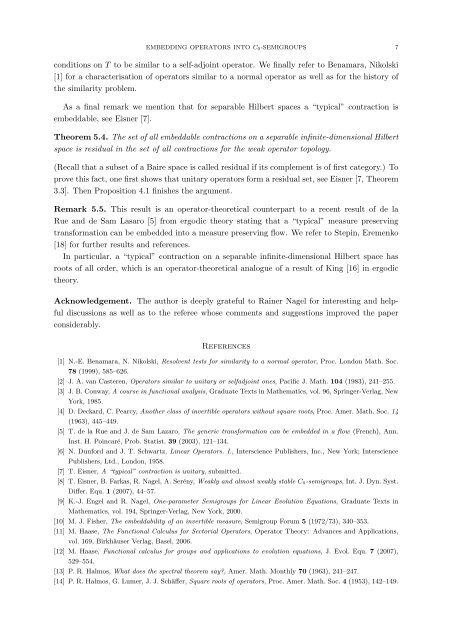EMBEDDING OPERATORS INTO STRONGLY CONTINUOUS ...
EMBEDDING OPERATORS INTO STRONGLY CONTINUOUS ...
EMBEDDING OPERATORS INTO STRONGLY CONTINUOUS ...
You also want an ePaper? Increase the reach of your titles
YUMPU automatically turns print PDFs into web optimized ePapers that Google loves.
<strong>EMBEDDING</strong> <strong>OPERATORS</strong> <strong>INTO</strong> C 0 -SEMIGROUPS 7<br />
conditions on T to be similar to a self-adjoint operator. We finally refer to Benamara, Nikolski<br />
[1] for a characterisation of operators similar to a normal operator as well as for the history of<br />
the similarity problem.<br />
As a final remark we mention that for separable Hilbert spaces a “typical” contraction is<br />
embeddable, see Eisner [7].<br />
Theorem 5.4. The set of all embeddable contractions on a separable infinite-dimensional Hilbert<br />
space is residual in the set of all contractions for the weak operator topology.<br />
(Recall that a subset of a Baire space is called residual if its complement is of first category.) To<br />
prove this fact, one first shows that unitary operators form a residual set, see Eisner [7, Theorem<br />
3.3]. Then Proposition 4.1 finishes the argument.<br />
Remark 5.5. This result is an operator-theoretical counterpart to a recent result of de la<br />
Rue and de Sam Lasaro [5] from ergodic theory stating that a “typical” measure preserving<br />
transformation can be embedded into a measure preserving flow. We refer to Stepin, Eremenko<br />
[18] for further results and references.<br />
In particular, a “typical” contraction on a separable infinite-dimensional Hilbert space has<br />
roots of all order, which is an operator-theoretical analogue of a result of King [16] in ergodic<br />
theory.<br />
Acknowledgement. The author is deeply grateful to Rainer Nagel for interesting and helpful<br />
discussions as well as to the referee whose comments and suggestions improved the paper<br />
considerably.<br />
References<br />
[1] N.-E. Benamara, N. Nikolski, Resolvent tests for similarity to a normal operator, Proc. London Math. Soc.<br />
78 (1999), 585–626.<br />
[2] J. A. van Casteren, Operators similar to unitary or selfadjoint ones, Pacific J. Math. 104 (1983), 241–255.<br />
[3] J. B. Conway, A course in functional analysis, Graduate Texts in Mathematics, vol. 96, Springer-Verlag, New<br />
York, 1985.<br />
[4] D. Deckard, C. Pearcy, Another class of invertible operators without square roots, Proc. Amer. Math. Soc. 14<br />
(1963), 445–449.<br />
[5] T. de la Rue and J. de Sam Lazaro, The generic transformation can be embedded in a flow (French), Ann.<br />
Inst. H. Poincaré, Prob. Statist. 39 (2003), 121–134.<br />
[6] N. Dunford and J. T. Schwartz, Linear Operators. I., Interscience Publishers, Inc., New York; Interscience<br />
Publishers, Ltd., London, 1958.<br />
[7] T. Eisner, A “typical” contraction is unitary, submitted.<br />
[8] T. Eisner, B. Farkas, R. Nagel, A. Serény, Weakly and almost weakly stable C 0-semigroups, Int. J. Dyn. Syst.<br />
Differ. Equ. 1 (2007), 44–57.<br />
[9] K.-J. Engel and R. Nagel, One-parameter Semigroups for Linear Evolution Equations, Graduate Texts in<br />
Mathematics, vol. 194, Springer-Verlag, New York, 2000.<br />
[10] M. J. Fisher, The embeddability of an invertible measure, Semigroup Forum 5 (1972/73), 340–353.<br />
[11] M. Haase, The Functional Calculus for Sectorial Operators, Operator Theory: Advances and Applications,<br />
vol. 169, Birkhäuser Verlag, Basel, 2006.<br />
[12] M. Haase, Functional calculus for groups and applications to evolution equations, J. Evol. Equ. 7 (2007),<br />
529–554.<br />
[13] P. R. Halmos, What does the spectral theorem say?, Amer. Math. Monthly 70 (1963), 241–247.<br />
[14] P. R. Halmos, G. Lumer, J. J. Schäffer, Square roots of operators, Proc. Amer. Math. Soc. 4 (1953), 142–149.
















